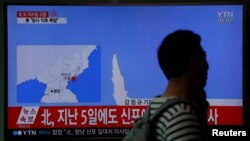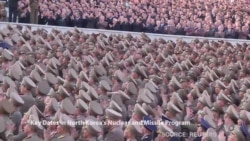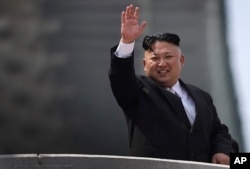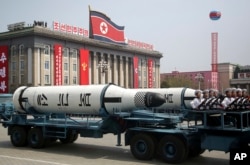North Korea conducted a failed missile test Sunday in defiance of increased U.S. warnings that there would be serious consequences for such provocative actions, including a possible military response.
A White House foreign policy adviser said the type of missile that North Korea tried to fire Sunday was medium-range and it exploded 4-5 seconds after it was launched near the country’s submarine base in Sinpo in South Hamgyong Province on the east coast of the country.
According to the adviser, who is traveling with Vice President Mike Pence, the U.S. had good intelligence before and after the launch. No planned response is expected from the Trump administration because there was no need for the U.S. to reinforce the failure.
The official, who spoke on condition of anonymity, said that had it been a nuclear test, “other actions would have been taken by the U.S.”
U.S. Vice President Mike Pence was briefed on the failed launch and had been in touch with President Donald Trump, White House aides said.
Pence arrived in Seoul Sunday to begin a 10-day trip to Asia. The vice president was joined by his wife and two adult daughters. After laying a wreath at the Seoul National Cemetery, he was expected to join U.S. and South Korean troops for Easter church services and a dinner later in the day.
U.S. Defense Secretary Jim Mattis released a statement following the missile test saying, “The president and his military team are aware of North Korea’s most recent unsuccessful missile launch. The president has no further comment.”
Watch: Key Dates in North Korea's Nuclear and Missile Program
Sunday’s attempted missile launch was reportedly not an intercontinental ballistic missile (ICBM) that Trump warned would not be allowed to happen, because it would move North Korea closer to acquiring a long-range nuclear ballistic missile capability that could directly threaten U.S. national security.
The failed test occurred as a U.S. naval strike force moves into the region in a show of force, and amid increasingly tough warnings from the Trump administration that the U.S. is prepared to take increased measures against North Korea that include possible military action.
On Saturday North Korean leader Kim Jong Un presided over a massive military parade that prominently displayed what appeared to be new long-range and submarine-based missiles. The parade was part of a celebration of the April 15 birthday of its founding leader, the late Kim Il Sung, the country’s most important holiday known as the Day of the Sun.
North Korea, however, did not go through with a nuclear test Saturday that many expected, based on reports of recent activity at the Punggye-ri nuclear test site indicating a test was imminent.
Pence visit
Vice President Pence and his wife Karen arrived in Seoul Sunday to begin a 10-day trip to Asia. After placing a wreath at the Seoul National Cemetery, he joined U.S. and South Korean troops for Easter Sunday church services and a dinner.
At the fellowship dinner, Pence said North Korea's "provocation" is a reminder of the risks U.S. and South Korean service members face every day "in the defense of the freedom of the people of South Korea and the defense of America in this part of the world.''
On Monday Pence will meet with acting South Korean President Hwang Kyo-ahn to reinforce the U.S. commitment to its ally in the face of rising tensions over the North’s weapons programs, according to his aides.
South Korea’s Foreign Ministry issued a statement Sunday saying, “North Korea showing a variety of offensive missiles at yesterday’s military parade and daring to fire a ballistic missile today is a show of force that threatens the whole world.”
The leaders Pence are to meet with in Seoul, however, will soon be out of office; South Korea is in the middle of a presidential campaign because of the recent impeachment of conservative President Park Geun-hye. Park was forced from office for her alleged involvement in a multimillion dollar corruption and bribery scandal. She currently sits in prison as prosecutors pursue a possible criminal indictment. The presidential election is scheduled for May 9.
In a recent presidential debate, all the top party candidates, representing both liberal and conservative views, spoke out against the U.S. taking unilateral military action against North Korea. And the two leading candidates, Moon Jae-in with the Democratic Party and Ahn Cheol-soo with the People’s Party, both support direct dialogue with North Korea to reduce tensions, positions that may put them in opposition to U.S. policy.
Submarine-based missiles
Sunday’s failed missile test occurred near the naval base in Sinpo where North Korea is reportedly developing a sea-based nuclear deterrent.
Pyongyang launched a ballistic missile from the same region earlier this month ahead of a summit between President Trump and Chinese President Xi Jinping, where they discussed the North Korean nuclear threat.
U.S. officials said that missile appeared to be a liquid-fueled, extended-range Scud missile that flew about 60 km, only a fraction of its range, before spinning out of control.
Analysts say North Korea is years away from developing a submarine launch based missile capability (SLBM), but with each test it moves one step closer. From a strategic standpoint a credible North Korean SLBM capability could nullify the advantage of the U.S. THAAD missile defense system being deployed in South Korea. Analysts say submarines can be positioned outside of the THAAD radar field of vision that is forward looking toward the North.
China opposes THAAD as a threat to its own security, but also has spoken out against North Korea’s missile and nuclear tests and has supported U.N. sanctions. China on Friday again called for talks to defuse the crisis.
Youmi Kim and The Associated Press contributed to this report.

















